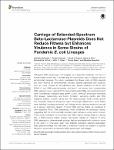Carriage of Extended-Spectrum Beta-Lactamase-Plasmids Does Not Reduce Fitness but Enhances Virulence in Some Strains of Pandemic E. coli Lineages
Schaufler, Katharina
Semmler, Torsten
Pickard, Derek J.
Toro, María de
Cruz, Fernando de la
Wieler, Lothar H.
Ewers, Christa
Guenther, Sebastian
Pathogenic ESBL-producing E. coli lineages occur frequently worldwide, not only in a human health context but in animals and the environment, also in settings with low antimicrobial pressures. This study investigated the fitness costs of ESBL-plasmids and their influence on chromosomally encoded features associated with virulence, such as those involved in the planktonic and sessile behaviors of ST131 and ST648 E. coli. ESBL-plasmid-carrying wild-type E. coli strains, their corresponding ESBL-plasmid-“cured” variants (PCV), and complementary ESBL-carrying transformants were comparatively analyzed using growth curves, Omnilog® phenotype microarray (PM) assays, macrocolony and biofilm formation, swimming motility, and RNA sequence analysis. Growth curves and PM results pointed toward similar growth and metabolic behaviors among the strains. Phenotypic differences in some strains were detected, including enhanced curli fimbriae and/or cellulose production as well as a reduced swimming capacity of some ESBL-carrying strains, as compared to their respective PCVs. RNA sequencing mostly confirmed the phenotypic results, suggesting that the chromosomally encoded csgD pathway is a key factor involved. These results contradict the hypothesis that ESBL-plasmid-carriage leads to a fitness loss in ESBL-carrying strains. Instead, the results indicate an influence of some ESBL-plasmids on chromosomally encoded features associated with virulence in some E. coli strains. In conclusion, apart from antibiotic resistance selective advantages, ESBL-plasmid-carriage may also lead to enhanced virulence or adaption to specific habitats in some strains of pandemic ESBL-producing E. coli lineages.
No license information

